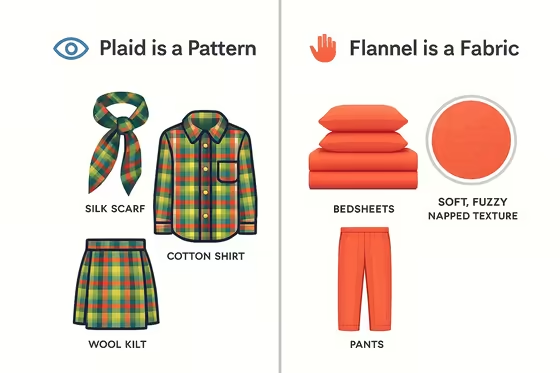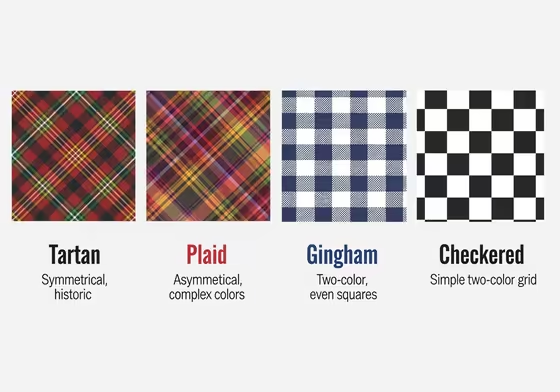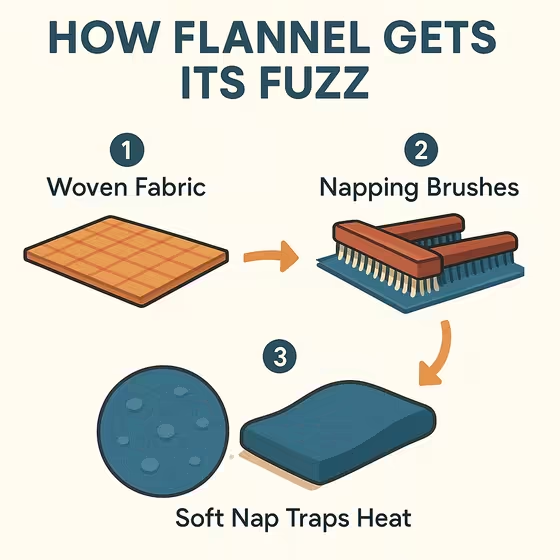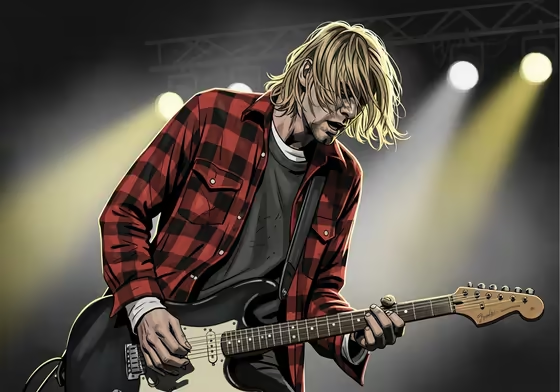What's the Difference Between Plaid and Flannel?
People often say "plaid" and "flannel" like they mean the same thing. You might call any warm, patterned shirt a "flannel," even if it’s not made of flannel fabric. This common mix-up started with one very popular shirt that has been around for a long time.
So, let's set the record straight and separate these two terms. It's time to figure out what makes them different.
Here's the main point: Plaid is a pattern you see, but flannel is a fabric you feel. A "plaid flannel shirt" is just a mix of both , but they are two different things. And sometimes, the word plaid doesn't even refer to a pattern at all.
The Main Difference: Pattern vs. Fabric
The best way to understand the difference is to look at each one by itself. One is about looks, and the other is about feel.

Plaid is a Pattern You See
Plaid is just how something looks. It's not a type of clothing or a material. It's all about the visual design.
- What it is: Plaid is a pattern made of horizontal and vertical stripes that cross over each other. These stripes come in different colors and sizes.
- What it looks like: When these colorful lines cross, they make a grid of squares and rectangles. This complex, repeating grid is what makes a pattern a plaid .
- How it's used: Since it's just a pattern, plaid can be put on any fabric. Sometimes, the pattern is woven right into the cloth using different colored threads. Other times, it's just printed on top of the fabric.
This means you can find plaid on all sorts of things, like silk scarves, light cotton shorts, or wool skirts. These materials are nothing like flannel.
Flannel is a Fabric You Feel
Flannel is a type of soft, woven cloth. You know it's flannel by how it feels, not by how it looks.
- What it is: Flannel is known for its soft and fuzzy feel. It's great for keeping you warm.
- How it's made: This softness usually comes from a process called "napping." After the fabric is woven, fine metal brushes rub against it to pull up tiny fibers. This creates a fuzzy surface on one or both sides, which makes the fabric feel soft.
- What it's made of: Flannel can be made from different materials. It was first made from wool, but today you can find flannel made from cotton, wool, or other fibers.
Because flannel is a fabric, it can be any solid color. You can easily find gray, blue, or white flannel that has no pattern at all.
How They Work Together (and Apart)
The confusion happens because of the "plaid flannel shirt." This is where a plaid pattern is put on flannel fabric. The shirt became so popular that people started to think the two things were the same.
The best way to see they're different is to look at examples where they exist on their own.
-
Plaid pattern without flannel fabric:
- Madras Shorts: Madras is a type of plaid with bright colors. It's used on thin, light cotton for summer clothes, which is the opposite of warm flannel.
- Tartan Kilts: A Scottish kilt has a tartan pattern, which is a specific kind of plaid. But the fabric is a heavy wool that isn't soft and fuzzy like flannel is .
- Formal Wear: You can find plaid patterns on dress shirts, silk scarves , and skirts. Here, the plaid is just for looks on smooth fabrics.
-
Flannel fabric without a plaid pattern:
- Bed Sheets: Flannel sheets are popular in winter because the fabric is warm and cozy. They are often sold in solid colors like white or gray.
- Gray Flannel Pants: A classic style, "gray flannels" were pants made from soft, woolen flannel fabric . They were known for their solid gray color and soft feel.
- Solid Flannel Shirts: You can buy solid-colored flannel shirts in navy, black, or green. These shirts give you the warmth of the fabric without any pattern.
These examples show that putting plaid and flannel together is a choice, not a rule. Flannel was chosen for its warmth and comfort. Plaid was chosen for its looks and style.
What Exactly Is Plaid?
To really get it, you need to know how to spot plaid compared to other patterns.
What Makes a Pattern Plaid?
Plaid has crisscrossing stripes of different widths and colors. To know if you're looking at plaid, look for variety and complexity.
If a pattern is just a simple grid of same-sized squares in two colors, it's a check, not a plaid. If it has many colors and lines of different thicknesses, then it's a plaid. This complexity is what separates plaid from simpler patterns.
Plaid vs. Other Patterns
People often use the word "plaid" for any square-like pattern. But there are important differences between plaid and other checked designs.

Plaid vs. Tartan
This is the trickiest one.
- The Rule: All tartans are plaids, but not all plaids are tartans .
-
Tartan:
Tartan is a
special kind
of plaid pattern. It has a few key features:
- It's perfectly symmetrical, meaning the stripe pattern is the same horizontally and vertically.
- It comes from Scotland and is tied to a specific Scottish clan or family .
- It has a specific name, like "Royal Stewart" or "Black Watch."
- Plaid: "Plaid" is the general name for these crisscross patterns. A modern plaid shirt doesn't need to be symmetrical or have any historical meaning.
-
A Weird Twist: In Scotland, the word "plaid" actually refers to a piece of clothing , like a blanket worn over the shoulder. When Scottish immigrants came to America, Americans started using the word "plaid" to describe the pattern itself.
Plaid vs. Gingham
This one is all about simplicity. Gingham is a simple check, not a complex plaid.
-
Gingham:
This pattern is very simple and has two main features:
- It's always a two-color pattern , usually one color plus white.
- It's made of even-sized stripes that form uniform squares.
- How to tell them apart: Plaid is complex, with many colors and different-sized lines. Gingham is simple, with just two colors and a grid of identical squares.
Plaid vs. Checkered
This is about how the words are used.
- The Big Picture: "Checkered" or "check" is the general term for any pattern made of squares. So, a plaid is just a more complex type of check .
- Simple Check: Usually, a "check" pattern is a simple grid with two alternating colors and even squares.
- How to tell them apart: A simple check is a basic two-color grid. A plaid uses more colors and has a more varied and complicated layout.
Other types of plaid include Madras, a colorful plaid from India, and Buffalo Plaid, a large two-color plaid.
What Is Flannel Fabric?
Flannel has nothing to do with patterns. It’s a fabric defined by how it's made and how it feels.
How Flannel Feels and Works
Flannel is known for being soft, fuzzy, and cozy. This texture isn't just for comfort; it also helps keep you warm.
The warmth comes from the "napping" process. Here’s how it works:

- The fabric (usually cotton or wool) is woven. At this point, it's still flat.
- The cloth is run through a machine with fine wire brushes . The brushes rub the surface of the fabric.
- This brushing pulls up tiny fibers, creating a fuzzy raised surface called a "nap."
This fuzz creates tiny air pockets on the fabric. These pockets trap your body heat, which keeps you warm. So the softness of flannel is directly related to its main job: insulation.
Types of Flannel
Since flannel is defined by its texture, it can be made from different materials .
- Wool Flannel: This was the original flannel. Wool flannel is heavy, durable, and very warm, which is why it's used for coats and pants.
- Cotton Flannel: This is the most common type of flannel today. It's lighter and softer than wool, making it popular for shirts and bed sheets.
- Synthetic Flannel: Flannels can also be made with fibers like polyester. These blends are often used to make the fabric more durable and less expensive.
Flannel vs. Flannelette
Flannelette isn't a different fabric. It's just a specific type of flannel .
- What it is: Flannelette is a lightweight flannel made from cotton.
- The history: Years ago, "flannel" usually meant it was made of wool. When companies started making a similar soft fabric from cotton, they called it "flannelette" to show it was different.
- Today: Now, the terms are often used for the same thing. But "flannelette" still tends to mean a lighter cotton flannel used for things like pajamas and baby clothes.
Why Are Flannel Shirts Usually Plaid?
So if they're different, why do we see them together so much? The answer is a mix of history and culture.
The History of Plaid and Flannel
Flannel and plaid started in different places for different reasons.
Flannel fabric was first made in 17th-century Wales. Farmers there brushed their woolen cloth to make it warmer and tougher for the cold, wet weather. It was a practical fabric for working people.
Plaid patterns, especially tartans, came from Scotland. They were used to show which family or clan someone belonged to. Tartan was about identity.
These two things came together in America. Manufacturers started putting popular plaid patterns onto warm, durable flannel fabric. This made the perfect shirt for lumberjacks, railroad workers, and pioneers who needed clothes that were tough and warm.
How Plaid Flannel Got So Popular
The plaid flannel shirt really became an icon in the 1990s.

This was because of the grunge music scene in the Pacific Northwest. Bands like Nirvana and Pearl Jam wore plaid flannel shirts. They were rejecting the flashy, expensive fashion of the 1980s.
The plaid flannel shirt was seen as comfortable, authentic, and unpretentious. The same shirt that was a symbol of hard work became a symbol of rebellion. This dual identity is why the connection between plaid and flannel is so strong in our minds.
A Great Example: Buffalo Plaid
You can find solid-colored flannel shirts and non-flannel plaid shorts, but the best example of the combination is Buffalo Plaid.
So, is buffalo plaid the same as flannel? Nope. Buffalo Plaid is a pattern, not a fabric. It's a type of plaid with large, bold blocks, usually in red and black.
But, it's the pattern you see most often on flannel fabric. The "Buffalo Plaid Flannel Shirt" is the classic example of the two coming together.
The story of where Buffalo Plaid came from is a perfect summary.
- Some say it came from a Scottish tartan.
- Others say it was created in the U.S. by a designer at Woolrich Woolen Mills .
- And some believe the pattern was used by Native American tribes first.
This mix of Scottish heritage, American workwear, and frontier life is exactly why this pattern and fabric became so linked.
Plaid vs. Flannel: Quick Chart
Here's a simple chart to break it all down.
| Attribute | Plaid | Flannel |
|---|---|---|
| Definition | A pattern | A fabric |
| Identified By | Sight (how it looks) | Touch (how it feels) |
| Main Feature | Crisscrossing lines of different colors and widths | A soft, "napped" surface that provides warmth |
| Can Be Made Of | Not a material (it's a pattern that can be put on any fabric ) | Wool, cotton, or synthetic fibers |
| Classic Example | A light cotton Madras plaid short or a silk plaid scarf | A solid gray flannel blanket or solid flannel pants |
| Iconic Combination | A Plaid Flannel Shirt (The fabric is flannel; the pattern is plaid) | |
Common Questions
So, is plaid the same as flannel?
No, they are totally different. Plaid is a pattern you see. Flannel is a fabric you feel. The confusion just comes from the popular "plaid flannel shirt," which has both.
Are tartan and plaid the same thing?
Not quite. Tartan is a special kind of plaid. The rule is: all tartans are plaids, but not all plaids are tartans. A real tartan has a symmetrical pattern, a specific name, and a connection to Scottish history. "Plaid" is just the general term for any pattern with crisscrossing lines.
Can a shirt be just one or the other?
Yes, for sure. This is the best way to see they're separate things.
- Plaid, not Flannel: A "plaid shirt" can be made of thin, light cotton. It has the plaid pattern but isn't a soft, warm flannel fabric.
- Flannel, not Plaid: A "flannel shirt" can be a solid color, like navy blue or gray. This shirt is made of the soft, warm fabric but has no pattern at all.